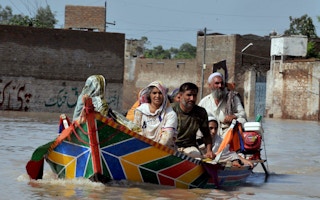Asia, the world’s most flood-prone region, is racking up a staggering damage bill. The latest data shows that for the last decade, flood-related economic losses in Asia has been at a high of US$30 billion annually.
To continue reading, subscribe to Eco‑Business.
There's something for everyone. We offer a range of subscription plans.
- Access our stories and receive our Insights Weekly newsletter with the free EB Member plan.
- Unlock unlimited access to our content and archive with EB Circle.
- Publish your content with EB Premium.
According to statistics from global reinsurance firm Swiss Re Institute, economic losses from climate-related natural disasters are growing by 5 to 7 per cent a year as the effects of a warming planet intensify.
Climate-related natural catastrophes resulted in US$270 billion in economic losses in 2021 — a 33 per cent year-on-year increase — with insured losses totalling US$111 billion, the fourth highest pay-out tally on record, said the Zurich-based organisation.
Hurricane Ida — second only to Hurricane Katrina as the most damaging storm ever to make landfall in the United States — was the costliest single natural disaster in 2021. The category four hurricane killed 115 people and caused $75 billion in damages.
Losses from floods, the most frequently occuring natural calamity, totalled US$82 billion globally, with severe inundation in Europe in July 2021 the costliest natural disaster on record in the region.
Seasonal floods in China were the most costly globally, amounting to US$23 billion in damages.
In the first quarter of 2022, flooding in eastern Australia cost the economy AU$1.45 billion (US$1.1 billion), claimed 21 lives, and left thousands homeless. In Malaysia, flooding in December and January cost RM6.1 billion (US$1.46 billion) and killed seven people.
Asia has suffered the highest flood-related economic losses in recent times, with annual flood damage in the region tallying US$30 billion a year, from 2011 to 2020.
Flooding is the most frequently occurring natural peril. It causes more than a third of all fatalities from natural catastrophes and 23 per cent of economic losses, the second highest after tropical cyclones.
However, only 34 per cent of damages from flooding was covered by insurance in advanced economies — and only 5 per cent of flood losses were insured in emerging markets.
The largest gap in flood protection is in Asia, with only 7 per cent of economic losses being covered by insurance. By contrast, in Europe, 34 per cent of flood losses are insured.
“Growing losses from floods are becoming ever more apparent,” said Jérôme Jean Haegeli, Swiss Re’s group chief economist. “Last year we had another wake-up call. There is a growing urgency for action to increase the resilience of societies,” he said, adding that more investment was needed in green infrastructure to mitigate flooding in high-risk areas.
Dr Zelina Ibrahim, assistant professor at the Faculty of Forestry and Environment, University of Putra Malaysia, said on a recent podcast that one-in-a-hundred-year rainfall events — like the one that hit Malaysia in December — are likely to occur once every decade by the end of this century as the planet warms.










